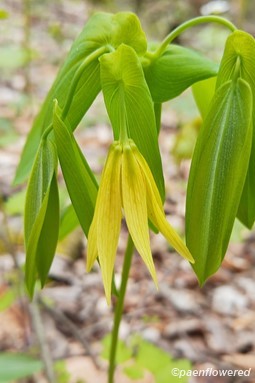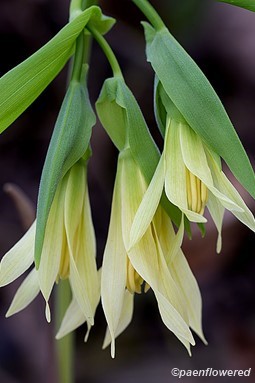Uvularia grandiflora
Uvularia grandiflora large-flower bellwort
Largeflower bellwort is a delicate spring-blooming wildflower native to North American woodlands. It is known for its drooping, bell-shaped flowers that are a soft yellow and appear in mid to late spring. The flowers are typically around 1-2 inches long and gracefully dangle from tops of stems. The leaves are a bright, fresh green and have a distinctive perfoliate arrangement, meaning the stem appears to pass right through the leaf. This gives the plant a unique, twisted appearance. It grows to about 12–24 inches tall and thrives in shaded, moist, well-drained soil. It is often found under decidious trees and is a perfect candidate for woodland or shade gardens.
Being a perennial, largeflower bellwort emerges from its rhizomatous root system each spring, grows and flowers, and then dies back to he ground in late summer or early fall. This timing aligns with its woodland habitat, where it takes advantage of the light available before the tree canopy fully develops.
Small bees, such as bumblebees and solitary bees are the primary pollinators of largeflower bellwort.
Habitat & Range
Infrequent in rich, moist, deciduous forests. Prefer shade to part-shade & rich, moist, well-drained soils.
Mostly found in west and north-central parts of the state.
Range: From southern Canada (Ontario and Quebec) down to the northeastern United States, extending as far west as Minnesota and Iowa. To the south, it can be found in parts of the Appalachian region, including Tennessee and northern Georgia.
Wetland Code: Not classified
Phenology
Flowers April to May. Flowers bloom for about two weeks.
Fruits July to August.
Characteristics
Flowers corolla and calyx soft yellow, bell-shaped, drooping; 6 yellow twisted tepals with 6 long stamens; 1–2″ long
Leaves simple, alternate, cauline, perfoliate, entire, medium green; broadly lance-shaped to oval with pointed tip; slighly hairy underneath; parallel veins; 4 to 6″ long
Stems slender, nodding, light green, smooth, branched (in mature plants); stem tops split into several pedicels, one per flower
Fruit 3-parted capsule broadest at tip, each part with several seeds
Height 12-24″
Plant Codes
S-rank: S4 (Apparently Secure)
G-rank: G5 (Secure)
Ecology
Bell-shaped yellow flowers attract a variety of pollinators, including bumblebees, mason bees, halictid bees, and andrenid bees, which visit the flowers to collect nectar and pollen.
Ants contribute to the plant's seed dispersal. Deer are one of the primary herbivores that browse on this plant's stems and leaves. Rabbits may also nibble on the plant occasionally.
Slugs and certain insect species might feed on the tender leaves, especially in young plants.





Comments
Have you spotted this plant in your area? We'd love to hear about your experience! Share your comments or questions about the plant below. Comments are moderated before posting.